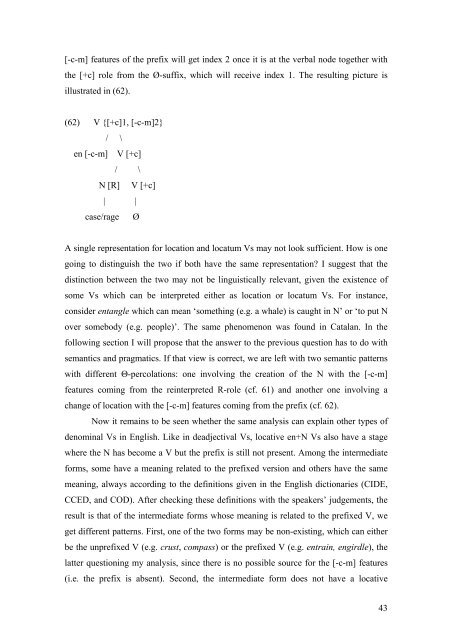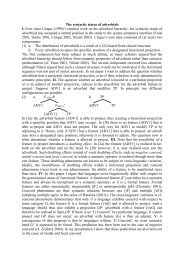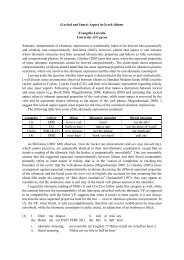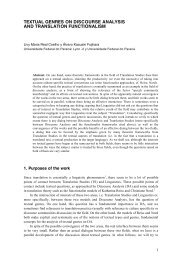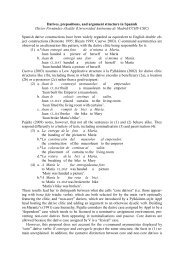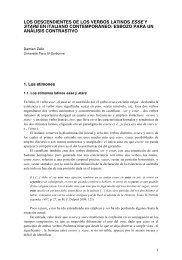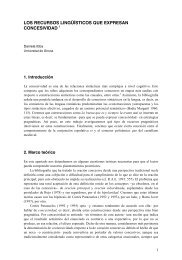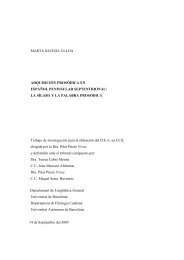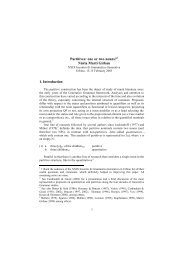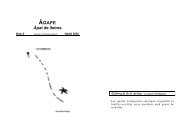Prefixation in English and Catalan - Departament de Filologia ...
Prefixation in English and Catalan - Departament de Filologia ...
Prefixation in English and Catalan - Departament de Filologia ...
Create successful ePaper yourself
Turn your PDF publications into a flip-book with our unique Google optimized e-Paper software.
[-c-m] features of the prefix will get <strong>in</strong><strong>de</strong>x 2 once it is at the verbal no<strong>de</strong> together with<br />
the [+c] role from the Ø-suffix, which will receive <strong>in</strong><strong>de</strong>x 1. The result<strong>in</strong>g picture is<br />
illustrated <strong>in</strong> (62).<br />
(62) V {[+c]1, [-c-m]2}<br />
/ \<br />
en [-c-m] V [+c]<br />
/ \<br />
N [R] V [+c]<br />
| |<br />
case/rage Ø<br />
A s<strong>in</strong>gle representation for location <strong>and</strong> locatum Vs may not look sufficient. How is one<br />
go<strong>in</strong>g to dist<strong>in</strong>guish the two if both have the same representation? I suggest that the<br />
dist<strong>in</strong>ction between the two may not be l<strong>in</strong>guistically relevant, given the existence of<br />
some Vs which can be <strong>in</strong>terpreted either as location or locatum Vs. For <strong>in</strong>stance,<br />
consi<strong>de</strong>r entangle which can mean ‘someth<strong>in</strong>g (e.g. a whale) is caught <strong>in</strong> N’ or ‘to put N<br />
over somebody (e.g. people)’. The same phenomenon was found <strong>in</strong> <strong>Catalan</strong>. In the<br />
follow<strong>in</strong>g section I will propose that the answer to the previous question has to do with<br />
semantics <strong>and</strong> pragmatics. If that view is correct, we are left with two semantic patterns<br />
with different Θ-percolations: one <strong>in</strong>volv<strong>in</strong>g the creation of the N with the [-c-m]<br />
features com<strong>in</strong>g from the re<strong>in</strong>terpreted R-role (cf. 61) <strong>and</strong> another one <strong>in</strong>volv<strong>in</strong>g a<br />
change of location with the [-c-m] features com<strong>in</strong>g from the prefix (cf. 62).<br />
Now it rema<strong>in</strong>s to be seen whether the same analysis can expla<strong>in</strong> other types of<br />
<strong>de</strong>nom<strong>in</strong>al Vs <strong>in</strong> <strong>English</strong>. Like <strong>in</strong> <strong>de</strong>adjectival Vs, locative en+N Vs also have a stage<br />
where the N has become a V but the prefix is still not present. Among the <strong>in</strong>termediate<br />
forms, some have a mean<strong>in</strong>g related to the prefixed version <strong>and</strong> others have the same<br />
mean<strong>in</strong>g, always accord<strong>in</strong>g to the <strong>de</strong>f<strong>in</strong>itions given <strong>in</strong> the <strong>English</strong> dictionaries (CIDE,<br />
CCED, <strong>and</strong> COD). After check<strong>in</strong>g these <strong>de</strong>f<strong>in</strong>itions with the speakers’ judgements, the<br />
result is that of the <strong>in</strong>termediate forms whose mean<strong>in</strong>g is related to the prefixed V, we<br />
get different patterns. First, one of the two forms may be non-exist<strong>in</strong>g, which can either<br />
be the unprefixed V (e.g. crust, compass) or the prefixed V (e.g. entra<strong>in</strong>, engirdle), the<br />
latter question<strong>in</strong>g my analysis, s<strong>in</strong>ce there is no possible source for the [-c-m] features<br />
(i.e. the prefix is absent). Second, the <strong>in</strong>termediate form does not have a locative<br />
43


